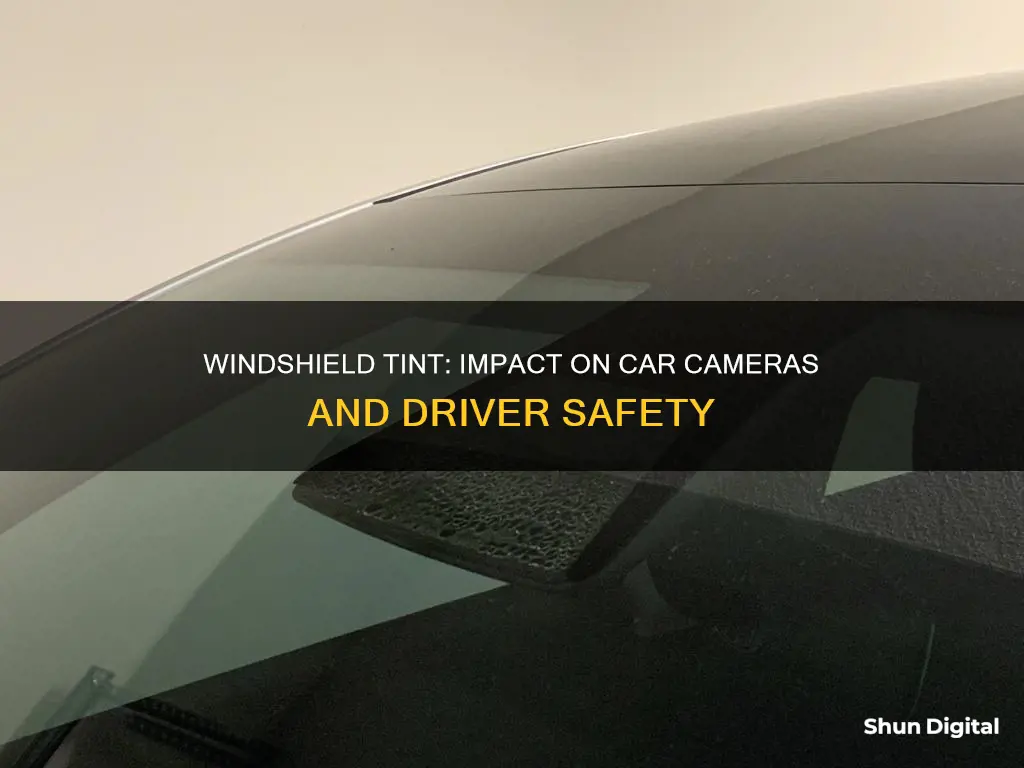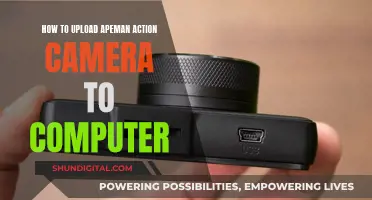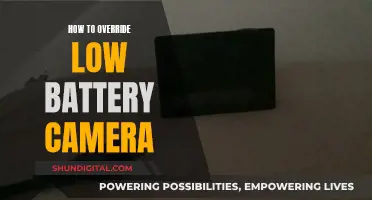
Tinted windshields can impact the visibility of car cameras, but the extent of this impact depends on various factors, such as the type of tint, the time of day, and the camera's placement. During the day, a tinted windshield can help reduce glare without compromising video quality. However, at night, the tint can restrict light transmission, resulting in reduced detail in the camera footage. The placement of the camera is crucial, and it is recommended to position it a few centimeters away from the edge of the tint to ensure optimal performance. Additionally, the darkness of the tint can affect visibility, with darker tints potentially obstructing the camera's view. While most car cameras can be mounted on tinted windows, careful consideration of these factors is necessary to achieve clear and unobstructed footage.
| Characteristics | Values |
|---|---|
| Effect on camera sensors | Window tint can affect visible light sensors but not infrared sensors. |
| Effect on video quality | During the day, tint may reduce glare but won't affect video quality. At night, tint can reduce the amount of light reaching the sensor, resulting in lower-quality footage. |
| Installation and removal | When installing a dash cam on tinted windows, it is recommended to use adhesive mounts and place the camera a few centimetres away from the edge of the tint. Removal can be tricky and may require special tools to avoid damaging the tint. |
| Workarounds | Enabling night vision in the camera settings or using a removable clear film window tint protector can help improve visibility through tinted windows. |
What You'll Learn

Tinted windows can impact dash cam visibility
During the day, tinted windows can help reduce glare without compromising video quality. However, at night, tints tend to restrict the amount of light reaching the camera sensor, resulting in reduced detail in the footage. This effect is more pronounced with darker tints and can be further exacerbated by using a CPL filter, which serves a similar function to tinted windows, darkening the video.
Infrared sensors in dash cams are not typically affected by tinted windows, as this type of light can pass through the glass. However, visible light sensors may be impacted by the tint, as it blocks some of the light from reaching the sensor.
To ensure optimal visibility through tinted windows, it is recommended to use a removable clear film window tint protector. This transparent film can be applied to the windshield, improving the effectiveness of the dash cam while maintaining the benefits of privacy that tinted windows provide. Additionally, careful placement of the dash cam is crucial, mounting it a few centimeters away from the edge of the tint can enhance its performance.
It is worth noting that the impact of tinted windows on dash cam visibility may also depend on the quality of the tint. Aftermarket and cheaper tints are more prone to peeling, which can be a concern when removing the camera. Therefore, it is advisable to choose a standard, quality tint for your vehicle.
Target's Camera Battery Options: What You Need to Know
You may want to see also

Night-time tint issues
Windshield tinting can cause problems for car cameras, especially at night or in low-light conditions. The tinting film applied to windows reduces the amount of light entering the vehicle, which can also reduce the amount of light reaching the camera sensor. This results in a darker image and a loss of detail.
The level of tinting will determine the severity of this effect. Tinting that is very dark or reflective will have a more noticeable impact on the camera's performance, while average-intensity tinting may not cause significant issues. It is recommended that tinting should not be darker than 20% to avoid any degradation in camera performance.
Some drivers have reported difficulties driving at night with tinted windows, especially if the tint is too dark. This can be further exacerbated by the use of auto-dimming mirrors, which can make it harder to see bicycles or other objects around the vehicle.
To compensate for the reduced light transmission, car cameras with night-vision capabilities can be used. These cameras enhance low-light images, improving visibility and detail capture. Additionally, enabling night vision settings on the camera can help offset the darkening effect of the tint.
Another factor to consider is the mounting and removal of the camera on tinted windows. It is crucial to get the placement right the first time, as adjusting or re-angling the adhesive mount can be challenging and may damage the tint film. Removing the camera from a tinted window requires special tools or techniques to avoid chipping or peeling the tint.
When deciding on windshield tinting, it is essential to balance the desired level of tint with the potential impact on camera performance and night-time visibility. While tinting can enhance comfort and privacy, it may require adjustments to ensure optimal camera functionality.
Browning Trail Cameras: Where Are They Manufactured?
You may want to see also

Tint removal
Removing tint from your car windows can be a challenging task, and it is recommended to seek professional assistance to avoid damaging your windows. However, if you choose to do it yourself, here is a detailed guide to help you through the process:
Gather Tools and Prepare the Area:
Before starting, make sure you have the necessary tools, which include a heat gun or steamer, a razor blade or scraper, adhesive remover, window cleaner, protective gloves, a face mask, and safety glasses. Choose a well-ventilated area, such as an outdoor space or a garage with the door open, to avoid inhaling dust and debris. Cover the interior of your vehicle and the surrounding area with tarps or plastic sheets to make cleanup easier.
Loosen the Adhesive:
Roll down the window slightly to access the edges of the tint. Apply heat to the window tint using a heat gun, steamer, or hair dryer. This will make the tint more pliable and help loosen the adhesive. Be patient, as this process can take several minutes.
Start Peeling:
Once the edges of the tint start to curl, carefully lift a corner of the tint using a razor blade or scraper. Work your way slowly and carefully around the edges to avoid damaging the window. Try to peel both layers of the tint simultaneously, as the second layer can be challenging to remove.
Pull the Tint Away:
After lifting a corner, gradually pull the tint away from the window. Do this slowly and evenly to avoid tearing or damaging the window or defroster. Be mindful of any defroster lines and radio antennas, as they can be easily damaged.
Remove Glue Residue:
Use adhesive remover, isopropyl alcohol, an ammonia solution, or nail polish remover to wipe away any remaining glue residue. Gently scrape or wipe the residue off, being careful not to damage the window or defroster.
Clean the Window:
Finish up by thoroughly cleaning the window with window cleaner and paper towels. Ensure all adhesive residue and remnants of the remover are wiped away.
Alternative Methods:
If you don't have access to a steamer or heat gun, there are a few alternative methods you can try:
- Use a hairdryer to warm up the tint, then use a razor blade to lift and peel it off.
- Spray an ammonia solution onto the window tint, cover it with plastic wrap, and let it soak for a few hours. Then, use a razor blade to peel off the tint.
- Use a razor blade to lift the tint film from a corner and slowly pull it off. After removing the film, use an ammonia solution or window cleaner to remove adhesive residue.
Professional Tint Removal:
Removing window tint can be challenging and time-consuming, and it may be best to seek professional help. Professional tint removal services have the expertise and tools to safely and efficiently remove the tint without damaging your vehicle. They can also assist with choosing and installing new tint films, saving you time and money.
Remember, removing window tint can be a delicate process, and it is important to take your time and work patiently to avoid any damage to your vehicle.
Unleashing Creative Control: Understanding Camera Raw's Power
You may want to see also

Infrared sensors
Window tinting can impact the performance of car cameras, but this effect is more pronounced during the night or in low-light conditions. Tinted glass can reduce the amount of light reaching the camera sensor, resulting in reduced detail in the footage. However, infrared sensors are unaffected by window tints because they allow infrared light to pass through.
Infrared-reflective (IR) windshields are designed to filter out infrared waves from sunlight while allowing visible light to pass through, making the glass transparent. This technology can reduce the amount of heat entering the vehicle, leading to a cooler interior and reduced reliance on air conditioning. IR windshields can reflect up to 50% of infrared energy back into the atmosphere, resulting in a more comfortable cabin temperature.
While IR windshields offer benefits, they also come with considerations. For example, radio-controlled devices like automatic car starters may require an IR-permeable patch to function properly. Additionally, IR-reflective windshields tend to be more expensive than regular windshields.
When choosing a window tint, it is important to consider the impact on camera sensors. Infrared sensors will not be affected, but visible light sensors may be impacted due to the reduced light transmission. It is recommended to select a standard, quality tint to ensure better and longer-lasting protection from the sun.
In summary, window tinting can impact car cameras, especially in low-light conditions, but infrared sensors remain unaffected. IR-reflective windshields offer benefits in terms of cooling and fuel efficiency, but they also come with certain limitations and a higher price tag. When choosing a window tint, consider its effect on camera sensors and opt for a quality product for optimal results.
Exploring the Creative Power of Camera Raw's Effects Tab
You may want to see also

CPL filters
A CPL (Circular Polarizing Lens) filter is an accessory that can be added to your dash cam to reduce glare and reflection. This can be especially useful if your car has a sloped back or curved windshield, which can cause more glare than vertical windshields. CPL filters can also be useful if there is any coating, film, or dirt/debris on the windshield, as these can lead to increased reflections.
When installing a CPL filter, it is important to ensure that there is no dust on the camera lens or the filter itself. You can adjust the CPL filter by rotating it, and it is recommended to do this in a sunny area so you can see the effect on the screen of your dash cam.
While CPL filters can improve image quality during the day, they can also make the image darker at night or in low-light conditions. This is because CPL filters block some light from reaching the camera sensor. If your car has tinted windows, using a CPL filter in combination with tinted windows can severely darken the image, as both perform the same function. Therefore, it is not recommended to use a CPL filter if your car has tinted windows.
There are several CPL filters available on the market that are compatible with various dash cam models. When choosing a CPL filter, it is important to ensure that it is compatible with your specific dash cam and vehicle model. Some CPL filters attach to the lens with adhesive, while others clip onto the lens housing or attach to the dash cam itself.
In conclusion, CPL filters can be a useful accessory to improve the image quality of your dash cam during the day by reducing glare and reflections. However, they may negatively impact image quality at night or in low-light conditions, especially when used in combination with tinted windows.
Smart Strategies for Carrying Camera Gear on Airplanes
You may want to see also
Frequently asked questions
Yes, windshield tint can affect the performance of car cameras, especially at night or in low-light conditions. The tint may reduce the amount of light reaching the camera sensor, resulting in reduced detail and potentially impacting the camera's functionality.
The level of tint can impact the performance of car cameras. If the tint is too dark (20% or lower), it may significantly reduce the amount of light reaching the sensor, degrading the camera's performance. Lighter tints are less likely to have a negative effect.
A tint strip typically allows for unobstructed video capture by a dash cam, as it only covers a small upper portion of the windshield. A full tint, on the other hand, can pose more challenges due to its wider coverage and higher density, especially if it is a dark tint.
To protect your tinted windshield, it is recommended to use a removable clear film window tint protector. This transparent film can be applied to your windshield and will not only maintain the integrity of the tint but also ensure clear and unobstructed footage from your dash cam.
Uninstalling a dash cam from a tinted windshield requires caution to avoid damaging the tint. Tools like a vinyl scraper or dental floss can be used to gently remove the adhesive. It is also recommended to heat the area with a hairdryer or heat gun to soften the adhesive before removal.







